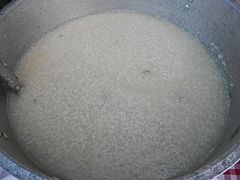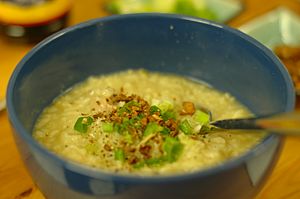Lugaw facts for kids

Basic lugaw
|
|
| Alternative names | pospas, lugao |
|---|---|
| Course | Main dish |
| Place of origin | Philippines |
| Main ingredients | glutinous rice |
| Variations | arroz caldo, goto |
| Similar dishes | Congee |
Lugaw, also spelled lugao, is a popular Filipino dish. It is a type of porridge made from glutinous rice. You can find lugaw in many forms, both savory and sweet. In the Visayan regions, people often call the savory kinds pospas. Many Filipinos consider lugaw a true comfort food. It is warm, soft, and easy to eat.
Contents
What is Lugaw?
Lugaw is a simple yet delicious rice porridge. It is a very comforting dish. People often eat it when they need something warm and easy to digest. It is popular for breakfast or when the weather is cold and rainy. Lugaw is also a common food for people who are sick. It is also given to very young children and older adults.
How is Lugaw Made?
Lugaw is usually made by boiling glutinous rice. This type of rice is also called malagkit in Tagalog. It becomes very sticky and soft when cooked. Sometimes, regular white rice is used instead. It just needs more water to become a porridge.
The basic lugaw is quite simple. It often has just salt, garlic, and ginger for flavor. Sweet versions might use sugar instead. For a richer taste, lugaw can be cooked in broth. This broth can be made from chicken, fish, pork, or beef.
Serving Lugaw
It is best to eat lugaw hot or warm. If it cools down, it can become thick and firm. You can easily reheat it by adding a little water. Sweet lugaw can even be eaten cold or partly frozen.
A Bit of History
Lugaw has been a part of Filipino food for a very long time. The National Commission for Culture and the Arts says it is one of the oldest Filipino dishes. It was even mentioned in a dictionary from 1613. This old dictionary, called Vocabulario de la lengua tagala, described lugaw as "rice mixed with milk or water or of both (porridge)."
Types of Lugaw
Lugaw can be enjoyed in many different ways. It can be served with various other dishes or ingredients.
Savory Lugaw
Many savory lugaw dishes are similar to Chinese-style congee. These were brought to the Philippines by Chinese-Filipino migrants. Over time, Filipinos added their own ingredients and flavors. Filipino savory lugaw is usually thicker than other Asian congees. This is because it uses glutinous rice.
Savory lugaw is often served with calamansi (a small citrus fruit). People also add soy sauce (toyo) or fish sauce (patis). These are used as condiments to add more flavor. Savory lugaw often goes well with meat or seafood dishes. A popular pairing is tokwa't baboy. This dish has cubed tofu and pork.
Arroz Caldo
Arroz caldo is a type of lugaw with a strong ginger flavor. It is topped with toasted garlic and scallions. A sprinkle of black pepper is also common. Many versions also include safflower (kasubha). This spice gives the dish its famous yellow color. A hard-boiled egg is often added too.
Goto
Goto is another savory lugaw. It is made with goto, which is tripe (part of a cow's stomach). Like arroz caldo, it has ginger. It is also garnished with toasted garlic, scallions, and black pepper.
Sweet Lugaw
Sweet versions of lugaw are very unique to the Philippines. They are delicious desserts or snacks.
Binignit
Binignit is a sweet lugaw made with coconut milk (gata). It includes various ingredients like fruit slices and jelly desserts. Common additions are sago (tapioca pearls) and kaong. It also has root crops such as sweet potato, taro, and ube (purple yam). Binignit has many other names depending on the region. Some names are giná-tan and ginat-ang lugaw.
Champorado
Champorado is a lugaw made with home-made chocolate and milk. It is a Filipino version of the Mexican drink champurrado. Traditionally, champorado is eaten with dried fish (tuyo). However, it is also enjoyed on its own as a sweet treat.
Ginataang Mais
Ginataang mais is a sweet lugaw that combines coconut milk with sweet corn. It is a simple and tasty dessert.
Ginataang Munggo
Ginataang munggo is a lugaw made with toasted mung beans. It is sweetened with sugar and cooked in coconut milk. Sometimes, corn is also added to this dish.



